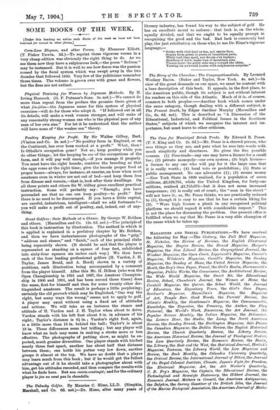Great Golfers: their Methods at a Glance. By George W.
Beldam and others. (Macmillan and Co. 12s. 6d. net.)—The principle of this book is instruction by illustration. The method in which it is applied is explained in a prefatory chapter by Mr. Beldam, and then we have instantaneous photographs of the "grip," "address and stance," and "finish," each of the principal clubs being separately shown. (It should be said that the player is represented as standing on a square of four feet, subdivided into sixty-four squares six inches each way.) We then have each of the four leading professional golfers (H. Vardon, J. H. Taylor, James Braid, and A. Herd) shown in a variety of positions, each illustration being accompanied by a comment from the player himself. After this Mr. H. Hilton (who won the Open Championship in 1891 and 1897, the Amateur Champion- ship in 1900 and 1901, and has been second three times) does the same, first for himself and then for some twenty other dis- tinguished amateurs. The result is perhaps a little perplexing; certainly the old proverb which may be Englished, " One way the right, but many ways the wrong," seems not to apply to golf. A player may excel without using a fixed set of attitudes and actions. We will take as an instance the stance and attitude of H. Vardon and J. H. Taylor when about to drive. Vardon stands with his left foot about 8 in. in advance of his right; Taylor's distance is 64 in. ; Vardon's right foot, again, is a little more than 15 in. behind the ball; Taylor's is about 13 in. These differences seem but trifling ; but any player will know what an inch may mean in making a stroke more or less effective. The photographs of putting show, as might be ex- pected, much greater diversities. One player stands with his feet nearly three feet apart, another has about half that distance between them; one holds his putter very low down, another grasps it almost at the top. We have no doubt that a player may learn much from this book ; but if he would get the fullest advantage out of it he should take a photographer about with him, get his attitudes recorded, and then compare the results with what he finds here. But non cuivis contingit; and for the ordinary player le jeu ne vast pas la chandelle.










































 Previous page
Previous page